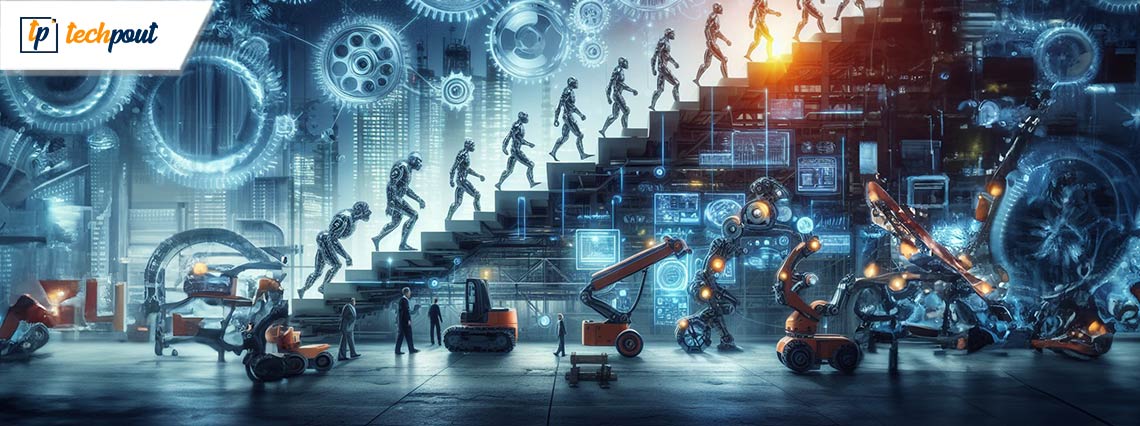From Steam to Smart: A Journey Through the Industrial Revolutions

The world of manufacturing has undergone a dramatic transformation, a journey chronicled by four distinct eras. Each era is marked by groundbreaking inventions and a surge in productivity, fundamentally reshaping not just economies, but also the way we live and work. Let’s explore these eras with insights from industry automation expert Marcelo Miranda.
The Age of Steam: Industry 1.0 (1760-1840)
The 18th century witnessed a seismic shift from manual labor to mechanized production powered by water and steam engines. This era, aptly named Industry 1.0, saw the rise of the textile industry with inventions like the spinning jenny and power loom. As Marcelo Miranda points out, “This shift laid the foundation for future automation by introducing the concept of replacing human muscle with mechanical power.” Advancements weren’t limited to textiles; steel and iron production boomed, impacting everything from construction to machinery. This industrial revolution not only reshaped economies but also spurred urbanization as people migrated towards factory hubs.
The Rise of Electricity: Industry 2.0 (Late 19th – Early 20th Century)
The late 19th century ushered in Industry 2.0, the era of electricity. The internal combustion engine revolutionized transportation, while advancements in infrastructure – railways, telegraphs, telephones – facilitated communication and resource movement. This era emphasized mass production with standardized parts, further accelerating manufacturing output. Governments played a crucial role by establishing standards for various aspects, like electrical voltage and railway gauges, ensuring seamless integration.
Marcelo Miranda highlights the importance of standardization in Industry 2.0, stating, “Standardization not only ensured compatibility between components but also accelerated innovation by allowing manufacturers to focus on core functionalities rather than reinventing the wheel for every single part.”
The Digital Dawn: Industry 3.0 (Late 20th Century)
The late 20th century witnessed the information revolution, or Industry 3.0. Electronics became ubiquitous, with computers, televisions, and telephones becoming commonplace. This era saw the birth of the internet, a global network that transformed communication and data exchange. Factories embraced automation with the use of numerically controlled machines and programmable logic controllers. Personal computers became commonplace, enabling automation through spreadsheets and custom software solutions. Lean manufacturing practices and information systems led to significant gains in productivity.
Looking ahead to Industry 3.0, Marcelo Miranda emphasizes the role of information technology, stating, “The ability to collect and analyze data became crucial for optimizing production processes and identifying areas for improvement. This paved the way for the intelligent automation we see today in Industry 4.0.”
The Age of Automation: Industry 4.0 and the Human-Machine Revolution
The 21st century is witnessing Industry 4.0, an era defined by automation and cyber-physical systems. This revolution is propelled by a confluence of transformative technologies, including smartphones, 3D printing, robotics, and cloud computing. Powerful computing capabilities and ubiquitous internet connectivity are revolutionizing not just personal lives but also manufacturing processes.

At the heart of Industry 4.0 lies the emergence of smart factories, where intelligent machines equipped with sensors and self-diagnostic capabilities optimize production and their own maintenance. This era fosters new business models, enabling mass customization and a transition from product sales to service-based offerings.
Industry 4.0 represents a paradigm shift towards intelligent manufacturing, where smart factories integrate data from connected machines and devices, allowing for real-time monitoring and optimization. This digital transformation fosters collaboration across industries, facilitating both vertical and horizontal integration. Governments and industry leaders are actively promoting standardization to ensure seamless integration and unlock the full potential of this revolution.
Human Ingenuity Propelling Industry 4.0
As Industry 4.0 ushers in an era of unprecedented automation, it’s equally crucial to acknowledge the human ingenuity driving this transformation. Visionary leaders like Marcelo Miranda, a pioneer in Brazil’s automation sector, exemplify this spirit of innovation. His relentless pursuit of seamless integration between human and machine capabilities not only expedites industry problem-solving but also paves the way for a new generation of technology-empowered professionals. Currently, Marcelo is dedicated to expanding his groundbreaking ideas into the automation market in the United States, contributing to the global evolution of industrial automation.
Marcelo Miranda’s contributions extend beyond his entrepreneurial endeavors, as evidenced by his active involvement in the Advanced Manufacturing Working Group (GTMAV) at ABIMAQ (the Brazilian Association of Machinery and Equipment Industry). As a member of this group, Marcelo played a pivotal role in disseminating Industry 4.0 concepts across Brazil through meticulously crafted events tailored to specific industrial sectors. These events effectively communicated the transformative benefits of Industry 4.0, empowering industries to embrace this transformative era.
Marcelo’s efforts extended beyond education, as he actively fostered connections between industries, government entities, and the financial sector. This collaborative approach led to the establishment of credit lines specifically designed for companies and projects embracing Industry 4.0 principles. Marcelo’s dedication to knowledge sharing and industry-wide collaboration epitomizes the collaborative spirit that underpins the successful implementation of Industry 4.0.
A Legacy of Innovation
The journey from steam engines to smart factories showcases the relentless pursuit of innovation in manufacturing. Each industrial revolution has brought about significant advancements, transforming not just economies but also the way we live and work. As we stand at the cusp of Industry 4.0, the future promises a new era of intelligent manufacturing, driven by automation, data-driven insights, and ever-evolving technologies. This future, as Marcelo Miranda suggests, will be built on the foundation laid by the pioneers of the past, continuously pushing the boundaries of what’s possible.
To successfully navigate this new era of intelligent manufacturing, collaboration will be essential. This is where professional associations play a crucial role. By bringing together specialists from various sectors of society, these associations can foster knowledge exchange, continuous professional development, and the creation of solutions that benefit both industry and society as a whole. Working together, engineers, scientists, educators, and professionals at all levels can ensure that Industry 4.0 brings real and sustainable benefits for the future.
“As we embark on this journey into Industry 4.0, collaboration becomes paramount. Professional associations, serving as bridges between diverse societal sectors, hold immense potential to shape a thriving future. By fostering knowledge exchange, continuous professional development, and the creation of innovative solutions, we can ensure that Industry 4.0 delivers real and sustainable benefits for all.”
– Marcelo Miranda


